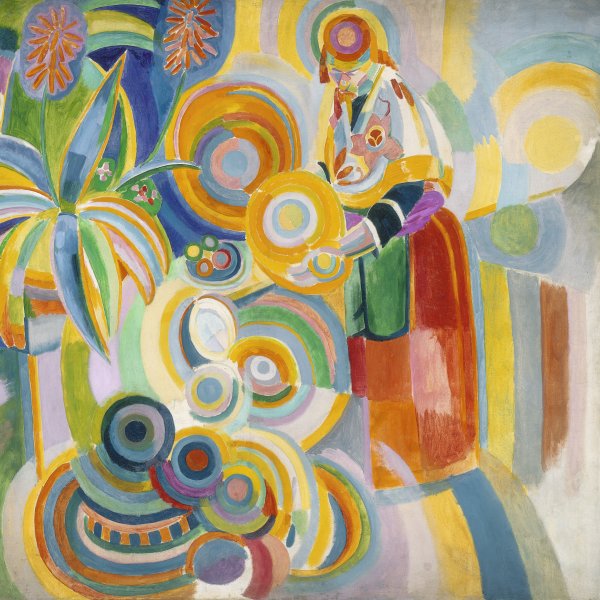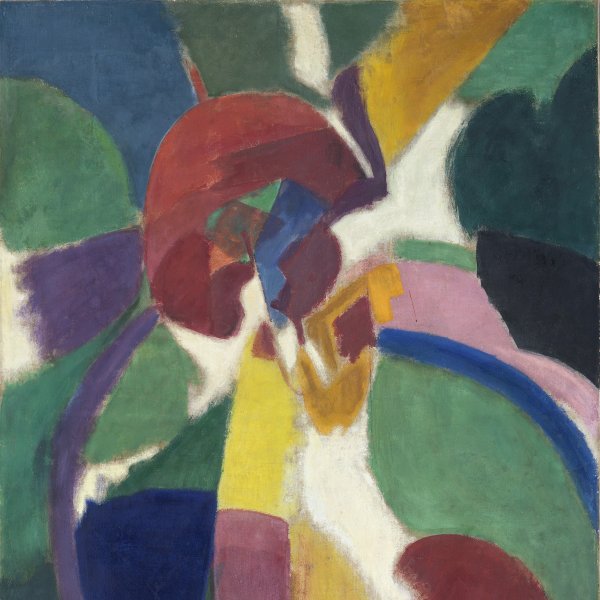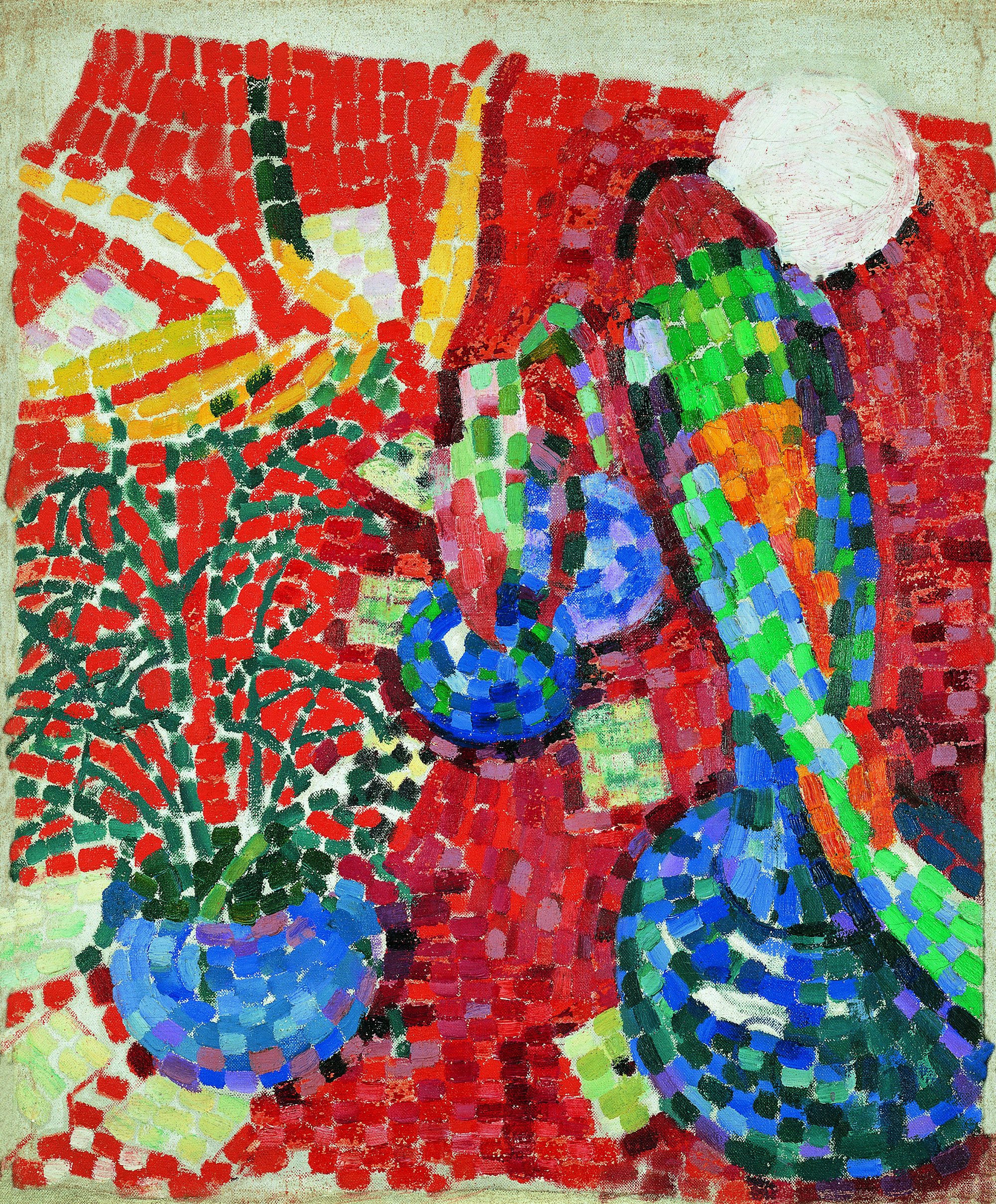Still-life with a Parrot
At the beginning of his artistic career, Robert Delaunay was notably influenced first by the Impressionist movement, whose atmospheric study of light he adopted, and subsequently by the Pont Aven group. The greater attention to volumes characteristic of the work of the latter group can also be found in Delaunay's The Market, 1905. He then attempted to reconcile these opposing tendencies regarding effusion of colour with a formal mastery of the subject matter. The discovery of neo-Impressionism at the Seurat retrospective held at the Salon des Indépendants of 1905, enabled him to formulate a first synthesis. In the course of the next two years (1905-1907), Delaunay adopted a broad divisionistic brushstroke through which he affirmed the autonomy of colour and its capacity to generate a moving form.
The work of the Fauves, whose brightly-coloured canvasses were the most striking novelty at the Salon d'Autumne of 1905, induced Delaunay to interpret with greater freedom the harmonic laws set out by Signac and stimulated him to bring pure colours together in a bold, uninhibited way. At the Salon des Indépendants of 1906 he was struck by the organisation into small cubes or tiles of the paintings of Signac, Cross and even Metzinger. In these works Delaunay discovered vibrant surfaces organised in a solid manner, constructed from an amalgam of brushstrokes of varying colours capable of recomposing the optical mobility of a light source on the viewer's retina without diluting its form. In the catalogue of Cross's exhibition at the Galerie Bernheim-Jeune in 1907, Maurice Denis evokes the pure colour style and emphasises the desire to realise architecture through this "tiled" brushwork. This structural lesson was retained by Delaunay who, together with Metzinger, appeared to want to interpret the Fauve emancipation as if filtered via the more structured starting-point of Henri Edmond Cross's luminous compositions.
Delaunay's encounter with Jean Metzinger, two years his elder, led him to adopt this same technique. Together with Metzinger, Delaunay began to consult scientific treatises on colour, particularly the works of Eugène Chevreul and Ogden Rood, whose existence he had discovered in Signac's D'Eugène Delacroix au néo-impressionnisme. Signac recommended a brushstroke that was "neat, and without retouches and of a size proportional to the format of the painting." A brushstroke which Delaunay applied, following Metzinger's advice, with methodical care and a novel breadth in the Still Life with a Parrot. Executed in the first half of 1907, this work marks the high point of his divisionist period. For this work, Delaunay chose an extremely strong palette of colours which enabled him to optimise, well beyond Chevreul's prescriptions, the organic shimmering of colours juxtaposed with their opposites. By associating dissonant contrasts with the harmonies of the analogy described by the French chemist, Delaunay covered the surface of the canvas with small rectangular sections of yellow, orange, blue and green over a dominant yellow-orange colour which corresponds to the two reflecting proximate colours mentioned by Rood in order to illustrate the circular force of this small interval. By playing simultaneously on the conjunction of complementary colours (blue-orange, yellow-violet) and dissonant colours (yellow-orange, blue-green) he obtained differently animated plays of colour which activate the eye's reactive capacities.
Together with the Fauve pictures, this still life has now shed all trace of the inert and heavy atmosphere of fin-de-siècle interiors. The still life genre was borrowed directly from Matisse's Fauvism. Matisse had exhibited a Still Life with a Red Carpet at the Salon in the Fall of 1906 which appears to have had a direct stylistic influence on Delaunay's Still Life with Gloves (dated 1906-1907), on his second version of Still Life with a Parrot, now in the museum in Colmar (1907), and on Three Goldfish (1907, Perrel Collection). The first two were probably those presented by Delaunay with the title Still Life. A Study at the Salon des Indépendants of 1907. It was on the occasion of this exhibition that Louis Vauxcelles-to whom we owe the term fauve-presented Delaunay as a "little savage, disciple of Matisse and Metzinger.
The refracting surfaces of the vases multiply the reflections of sunlight, whose rays seem concentrated on the upper right-hand side of the composition, in a white disk that recalls the surface obtained when the sort of chromatic disk Rood introduced is made to rotate quickly. Following Landscape with Solar Disk (1906-1907, Paris, Musée nationale d'art moderne) which marks the first appearance of the circular abstract form in his vocabulary, Delaunay attempted to reproduce a true centre of iridescence, to "create some sun, " to borrow the expression used in that same period by Maurice Denis for the works of Cross. From 1907 onward, Delaunay introduced the premises of a purely psychological reflection on painting, achieving in the very strong chromatic density from his orange colour a purely optical, almost hypnotic, effect that enabled him to liberate the pictorial space from its illusionist conventions in order to reach a direct visual language, without symbolic connotations. The modular paved structure, intertwined on the left with the grid of the stems of the tree-shaped plants, is sufficient to hold the composition together. On the right, the rhythmic play of the spiralling profiles of the parrot, of the vases, and of the luminous disk (inspired by the theories of Charles Henry on the generation of force) orient the viewer's eye movement by way of simultaneous contrasts. The colour no longer denotes a subject, rather, it bears witness, in the diffraction of light, to the "vital movement of the world, " and it offers the artist the possibility of reproducing on the inert canvas surface the sensory impulse from which originates our visual relation to the world.
This search for the origins allows us to interpret more accurately the exotic character of the motifs in this painting. While Picasso assimilated the distortions of African art in order to revise his conception of space, Delaunay developed an alternate form of Primitivism and found inspiration in the exoticism of the vases which his mother, Berthe Delaunay, brought back from the Orient. This choice was not fortuitous, rather it was directly encouraged by his encounter with the Douanier Rousseau, the great "modern primitive" with whom Delaunay would form strong bonds of friendship during the course of 1906. At the Salon des Indépendants of 1907, Delaunay's canvases are placed near those of Rousseau. A few weeks later, Rousseau was brought to Berthe Delaunay's sitting room where she commissioned The Snake-Charmer from him. Still Life with Parrot, executed at the time of these meetings, sums up Rousseau's initial stylistic influence on Delaunay who found in this people's painter an authentic form of archaism which he used in his re-formulation of his subject matter in a way that anticipates Cézanne's more conceptual innovations. The thick divisionist brushstroke sets up a dialogue with the archaic structure of Byzantine mosaics which Vauxcelles rightly compared to the naïve simplifications of the Douanier Rousseau.
The oriental splendour of Still Life with a Parrot comes just before his brief fauve phase and the important Cubist phase (1907-1912): a first Orphic hymn to light that announced the great multi-coloured Windows series in which Delaunay adopted the solar metaphor of illumination which would fuel his painterly research of colours in movement until 1914.
Pascal Rousseau







